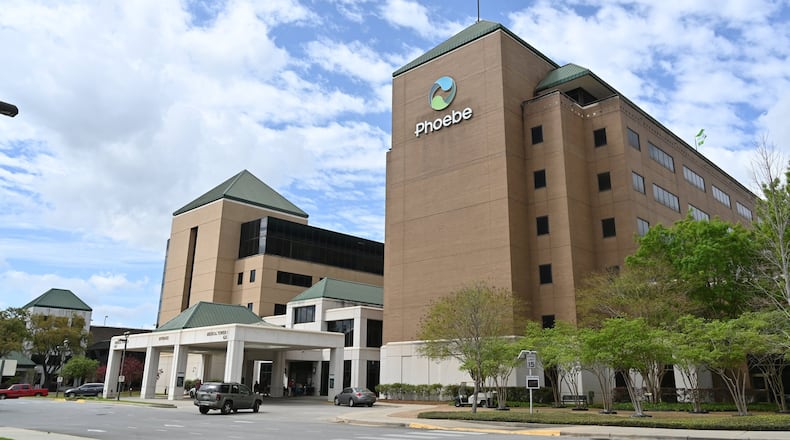Officials at Augusta University Health System were in state of shock days ago as they assessed the financial impact of the unprecedented push to prepare for a surge in coronavirus patients.
On its books, the hospital in just 30 days logged a loss of $22 million, largely the consequence of the halt in elective surgeries. To make things worse, as the losses piled up, expenses “went through the roof,” said Dr. Phillip Coule, chief medical officer of the 650-bed facility.
Now, Coule and other Georgia hospital leaders say the financial health of their institutions is at risk unless the federal government provides more money to health care providers that have borne the brunt of the coronavirus outbreak. Across the U.S., billions in relief dollars have been distributed to health care providers that haven’t been involved in treating large numbers of COVID-19 patients, while payments to other providers haven’t come close to covering their losses.
“We are hoping these compensation systems get straightened out,” Coule said.
So far in Georgia, the federal government has distributed more than $1 billion in early relief funds among nearly 4,900 health care providers. The money was sent in two rounds. Initially, the amount each received was based on their 2019 Medicare revenues, which meant that facilities that treated a lot of seniors got money even if they didn't have a huge coronavirus caseload. Then, the government switched to disbursing money based on total 2018 revenues, a move a Kaiser Family Foundation analysis found favored hospitals that primarily serve patients with private insurance.
» COMPLETE COVERAGE: Coronavirus in Georgia
» MORE: Georgia hospitals and coronavirus
The government also targeted rural hospitals, community health centers and clinics, sending $328 million to about 240 Georgia providers in rural areas.
Early this month, another $377 million in “high-impact” funds was disbursed to 18 Georgia hospitals that had provided care for 100 or more COVID-19 patients through April 10, and an additional $97 million in proportion to the amount of care the 18 hospitals provided to low-income and uninsured patients. Grady was among the hospitals that got significant boosts from those allotments, with payments of $54 million so far.
Still, one sharp criticism is that the federal government, at least early on, failed to conduct a proper evaluation of which providers faced the greatest challenges. Without an understanding of needs, money was routed to providers like medical equipment companies and labs, which may not have suffered losses because of the pandemic, and podiatrists and chiropractors, whose role with coronavirus patients was likely limited. The government even sent more than $747,000 to an Atlanta-based hospice, SGT Healthcare of Atlanta, that was ordered in March to pay $1.75 million for allegedly defrauding Medicare and Medicaid, the AJC found. Hospice officials did not respond to requests for comment.
"The federal government was in such a rush to get the money out that they didn't bother to look at and see whether the money they were sending to hospitals was a good investment or if they (the government) were just sending money as a gesture," said David Mosley, a Suwanee-based health care consultant who last month wrote in a white paper about the crushing impact of the coronavirus for rural hospitals.
Money was sent via direct deposits with little advance notice to health care providers, and some haven’t really understood how much or what they got or may be getting, said Heather George, chief revenue officer for Patientco, an Atlanta-based health care billing company. But others have seen federal money come fast and furiously, she said.
“It’s all moving so quickly,” George said.
In Augusta, Coule said that Congress tried to soften the financial blow to safety-net hospitals, which treat high numbers of indigent and uninsured patients. But the relief fell short. Less than half of the lost revenues at his facility were recouped, while expenses for more personal protective gear, staff overtime and additional testing continued to soar. Had he had more Medicare patients to fill his beds, instead of the young, uninsured patients that filled many, the hospital would have received more money, he noted.
“There’s a potential for people out there to be gaming the system,’’ Coule said. “My hope now is that they (the government) do what’s right for patients.”
Hard decisions
The American Hospital Association earlier this month said that hospitals and health systems could lose $202 billion through the end of June because of extraordinary COVID-19 expenses and lost revenues from cancellation of elective surgeries — and it said their situation is unlikely to improve after that.
Even at hospitals that didn’t see significant numbers of COVID-19 patients, the outbreak had a “substantial impact” on cash flow and revenue, said Anna Adams, of the Georgia Hospital Association.
More specifically, nonprofit hospitals, like Northeast Georgia Health System, operate on such narrow margins that losses of any kind can be devastating, said Brian Steines, the health system’s chief financial officer.
As they wait to see if the federal government will provide more relief — and how insurers might reimburse them for COVID-19 patients — Georgia hospitals are making some hard decisions.
Many have hired consultants to help them cut costs, and some have laid off or furloughed workers and cut salaries. Don Bivacca, managing director at Healthcare Management Partners, who is assisting in the effort, said many hospitals are also asking for deferrals on lease and rent payments.
But, “the No. 1 expense for a hospital is salaries,’’ Bivacca said.
To offset some of the financial strain, senior leaders at Northeast Georgia Health System took a 25 to 30 percent cut in compensation for the year. Staffing in non-essential areas has been reduced to match patient volumes, and some expansion and improvement projects have been paused, Steines said.
Hospitals are also trying to get in line for upcoming rounds of federal payments authorized by Congress, trying to figure out how they can tap the new resources, though there is little guidance on this.
“The hospitals may not be able to even anticipate what those reimbursements will look like,’’ said Maria Garcia, a Florida-based attorney who counsels hospitals on ways to obtain the new funding. “It’s definitely going to be a difficult time for hospitals to predict and plan.”
Meanwhile, the situation for some rural hospitals is desperate, said Jimmy Lewis, chief executive officer of HomeTown Health, an advocacy group for rural providers in Georgia.
He has worked for years with state officials to try to find funding to keep rural hospitals afloat. Just three months ago, he said, he was working with rural CEOs on ways to replenish their cash flows.
“Then the bottom fell out,’’ when COVID-19 struck Georgia, Lewis said.
As she struggles to make ends meet, Clinch Memorial Hospital Chief Executive Officer Angela Ammons has some difficult decisions to make.
In April, she received $1 million based on the Homerville hospital’s Medicare reimbursements from last year.
The money would have come in particularly useful on a recent day when the hospital, which is in a county of just 6,800 people, had 17 COVID-19 patients. But she has been advised not to touch the money in case it is needed later this summer to handle a resurgence of COVID-19 cases. She’s also wary that the government might want it back.
“We’re really trying to keep our heads above water,” Ammons said. “Before this pandemic hit, whatever momentum we were building came to a screeching halt.”
Lewis said other rural hospitals are also hesitant to use the relief money because of strings attached. Hospitals have to certify that they are complying with all the federal terms and conditions that come with the money.
“They felt that someday they would have to give it back,” Lewis said.
Garcia, the Florida attorney, said her hope is that the federal government will step up and do a better job of mitigating the crisis. It looks like the next wave of funding will be based on a hospital's level of Medicaid patients, a move sought by the National Association of Medicaid Directors. Though the amount of money to be distributed has not been determined and a timetable for distributing it is not set, the hope is that it may help health care providers that care for large numbers of low-income patients.
“I think they’re still deciding how to move forward with the second wave of payments,’’ Garcia said, “however it would make sense that you would look at as much data as you can so they can figure out a way to tie (funding) more to the number of patients in the population and those who are actually dealing with the virus.”
About the Author
Keep Reading
The Latest
Featured






